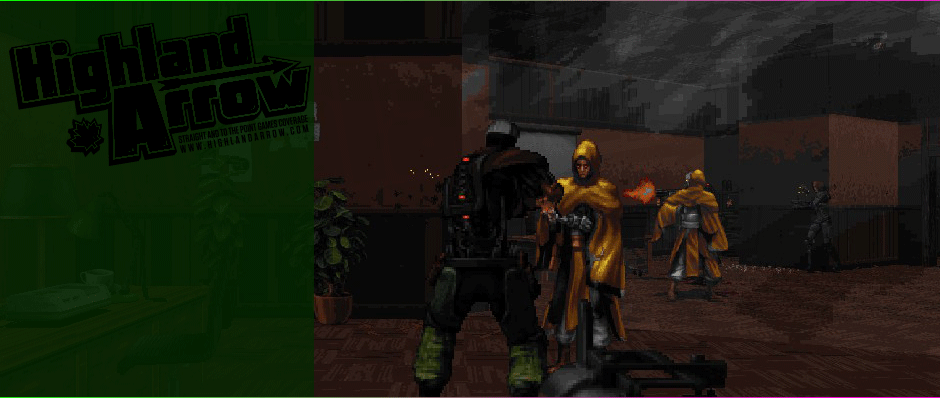

Ion Fury
Platforms: PC
Reviewed on: PC
Reviewer: Maiyannah Bishop
Review Play-Time: 12h
Developer: Voidpoint LLC
Publisher: 3D Realms
Released: 2019-06-18
Review Published: 2021-07-31
+ Great personality displayed in first bit
+ Excellent voice acting
+ First levels have some great design
+ Decent weapon variety
- Creativity of levels petters out in second half
- Wonky jumping mechanics
- Unchallenging, RNG-based boss fights
- Humanoid enemies not very distinctive

Editor's Note: Maiyannah's copy of the game was gifted to her by her partner.
Ion Fury is a cyberpunk-themed first-person shooter developed by Voidpoint LLC and published by 3D Realms. People following it may better recognize it as Ion Maiden, which it was named prior to the washed-up metal band Iron Maiden suing the developers presumably in some sort of grasping attempt to be relevant again. This is one I heard all kinds of buzz about when it first released, and then promptly very little, and having played it now, I think I understand why: Ion Fury is a very front-loaded game whose run-time lasts longer than the number of ideas it has to keep the game-play fresh. Looking at completion percentages on steam achievements in the game, most people make it half-way and then drop the game, and that seems about right, because it's about half the length of the game that's interesting - the second half is a real drag. Let's expand, shall we?
D.C. Meltdown
Much akin to Dusk which I previously reviewed, Ion Fury begins somewhat in media res. It starts with you in the shoes the protagonist in a bad while the big bad - voiced by Jon St. John - enacts his evil plan, smashing up said bar and sending the player in the role of Shelly “Bombshell” Harrison to enact justice for her spilled drink on the antagonist. I'm being a bit tongue-in-cheek with the description there, but so is the game in its premise: it represents a love letter to old action flicks by way of retro-style FPS, built on the EDuke32 source-port of the Build engine.
The design of the first few levels is very dense, with all kinds of little touches and details that belie a degree of care and attention placed on the world-building and atmosphere of the game. Those first handful of levels are absolutely drenched in the dull neon glow of the stereotypical dystopian cyberpunk future, and feature a variety of small interactions with the game world: little rolly-chair sprites drift about and swivel, garbage cans can be blown up for the occasional small reward of minor health bonuses or ammo, and so forth. While some of it definitely has the ”look what we did with the Build engine“ vibe to it, it is all interesting enough that I mostly excuse that.
Fan Service
Where I don't excuse that density is where it lays impediments across the proverbial tracks of the actual game-play: much of the set dressing becomes obstructive, and it was not terribly long before I was literally tripping over misplaced objects, trying to keep the mobility you need to have to stay alive at higher difficulties. It's here I have to confess, I dropped down from the highest difficulty to the normal difficulty, because when I'm dying because of circumstances that feel based upon luck rather than skill, it rapidly diminishes my admittedly slim-these-days as-is patience. I am not the kind of galaxy big brain genius such as juvenile delinquent and future robotic overlord John Carmack, so unfortunately I am unable to predict the trajectory of some random rolly chair that is going to jauntily launch itself to be in my way. I'm sure that's more of a “me” problem than the game though, I say with absolutely no sarcasm whatsoever at all. And you know: while that was a (genuinely) hilarious a way to die the first time, the charm had worn off by the fifth. It's a minor gripe, certainly, and by itself, I would have just given it a pass, but as you'll likely surmise going through this review, by the time we're done we'll have enough petty complaints we can sew them together into an awful Christmas sweater, just in time to make its way through our COVID19-addled courier systems in time to disappoint our loved ones for Christmas.
Those of you in my audience familiar with the Build engine underlying EDuke32 that this game runs on already know one of the things that I am going to complain about here: Build engine is notorious for its weirdly-lethal doors. To developer's credit, they definitely have tried to minimize this, but you will absolutely have some door-related accidents in this game, doubly so if you're not paying attention to the doors and trying to move rapidly through the levels, as the game more or less demands at the higher difficulty. Given they only swing one way usually, if you're opening it from the wrong side too close, you're just going to die. Death by door is annoying enough, but while they tried to minimize the usual Build engine door faff, if not eliminate it entirely, there's some new weirdness to complain about with Ion Fury. I don't know if it's an EDuke32 oddity or another confusing intentional choice of the developer, but there were instances where just running into closed doors killed me, and while I may give a chuckle at the normal Build-doors issue, that definitely was not very humorous to me. Indeed, it started with laughing at dying to silly things in the overly-populated levels, but it quickly turned into getting annoyed. I can definitely see less patient people pitching a fit over some of it. I never got to that point, but I could feel the frustration.
Hazard Disposal
In those first levels, I was more than willing to forgive the level design having those intrusive bits and bobs, because they were still interesting, and at least some of that difficulty was me acclimatizing to the movement. I don't remember having as much problems with the original Duke Nukem, and maybe it's some artifact of the particular source port used, but the movement felt imprecise and “lurchy”. Jumping is perhaps the most obvious example - it moves you in an arc up, but then down also somewhat before restoring you to the neutral height. It was as if Shelly was doing jumping squats, and felt weird. I did eventually get used to it, but I never quite liked it. Replaying OG Duke to see if that's just something I never remembered, I went jumping around for a good amount of time in Hollywood Holocaust while doing my best to not get shot, and what I immediately noticed is that the jump there is more where it has a little bounce after - still a bit weird, but not the lurching monstrosity Ion Fury has. On its own merits, however, it isn't something that detracts from the game, but it does feel strange, and took that getting used to. Talking to one of the developers on Twitter when I brought it up and they interjected, this is a deliberate change. And to that I have just one question: why? Having the movement feel so start-and-stop absolutely wrecks any feeling of fluidity and precision to the movement, and it ends up feeling more akin to SiN than Duke. Which, as I may get to further unpacking in the future with a review of said, is hardly a good word said.
The problem with the set dressing becomes much more than the moving objects, however, but also one of map direction. Good maps utilize a variety of factors that generate a natural push and pull that guides a player around the correct path through the level, and when you have all these secondary presentation elements placed without a thought given to that, or consideration to how it may direct or, more accurately, redirect the player, you have the mapping equivalent of spinning the player around a dozen times and expecting them to walk straight afterwards. That, coupled with the game's tenancy to spawning enemies in behind you, you have some of the maps - especially in the latter half of the game where they have less natural landmarks - are made very confusing to navigate. Now I do confess to being blonde as fuck, but I also tend to be the one in my group of friends who can generally bumble her way through these sorts of environments okay, so there's several others that are probably going to have it rougher than I, which is not a good prospect in this instance. In the end, the presentation wows, at least while the effort lasts, but that eventually tapers off, and when it does what you are left with is a confused map design that ends up disorienting to the player. It looks good, but it plays poorly.
Haskell's House of Horrors
A related issue is how those complex and complicated environments make discerning what is happening at a glance difficult, which is important if you want play with a high skill ceiling to be tenable. Let's directly compare to Doom, since it really is the grand-pappy of the genre. If you look at most of their line-up, each of them with perhaps the arguable exception of the zombieman and the shotgunner have a very clear and distinctive outline that you can use without even taking a moment to process the rest of what's going on to be able to know what kind of enemy you are dealing with. The rank and file of Doom's enemies are the zombiemen, imps, demons/spectres, and cacodemons - each of them quite different from shape from the others. The zombieman has a plain human shape, the imp has a bunch of horn protrusions, the demons are hunchbacked dump trucks, and the cacodemons are big, angry raspberries. Contrast this to Ion Fury where, while you do have a variety of enemies, the rank and file, as in Blood, consists of a bunch of guys in different-coloured robes, and as such enemies in this game are considerably more difficult to distinguish from one another. This is exacerbated by the fact that the red-robed dudes can pretty much insta-kill you with their shot from a distance, even on the easiest difficulty, and this skews things into the unfair end of not-well-designed. This does actually clear up the further in you go - the less dense maps make distinguishing them apart easier, but that's coming at a cost of the maps being less and less inspired the further from the starting maps you wade. Throw a horde of enemies in that appear to be hit scans into that mix, and well, I was just done with trying to get through it on the hard difficulty. The challenge didn't feel fair, and the game was not pulling me in enough to want to put up with an unfair difficulty for the sake of saying I beat it on the hardest setting.
To try to help ameliorate this, Ion Fury gives you a great selection of different weapons: a revolver, an electrified stun baton, “bowling bombs”, a chain gun, an SMG you can dual wield if you grab two, and a crossbow which is basically the sniper weapon. Each of these has a tongue-in-cheek name, such as the revolver being named “Loverboy”, and while its a bit over the top, that is entirely expected for a game of this sort, and they only add to the theming. Each of them feels and handles well, with different attacks and mechanics that give a great deal of variety and cater well to several different FPS play-styles, and the secondary attacks add even more options to the player. An example of this is how the secondary-fire mode of the revolver allows you to track enemies for a guaranteed hit - at the cost of some time. Each of them does have those costs and benefits and that's some genuine good design - there isn't one weapon that is leaned on more because it's more powerful, or “OP” as the vernacular goes, but rather if you do end up leaning on one weapon and using something less, it will be because you gel better with those choices. The game does very well with this, and it represents one of the pain points that made me as frustrated with the game as I am no doubt conveying in this review - as I have unfortunately had to say a few times in the past as well as now: I wanted to like this game considerably more than I actually did end doing. And the weapon variety is one of the key factors that contributed towards the positive end of that. Even that isn't without problems though: the projectiles don't often line up with the sights, the most egregious example probably being the “Penetrator” (hue hue hue) SMGs, which fires above and to the right of the crosshair, and the reverse is true of the opposite weapon if it is dual-wielded. Not a huge problem sure, but it does show a certain lack of attention to detail, and I can say with some certainty that someone with the sort of training and general Badassery™ that Shelly is supposed to have would understand how to zero a firearm's sight.
The All-Seeing Eye
The reason for which I bang on so thoroughly about how the maps present issues to the gameplay is they truly are a set of caltrops thrown across all the other mechanics, and even something I quite took to - the weapon variety - is affected by it. There's a variety of ways they manage to: mis-aligned crosshairs are common and annoying enough; but when the secondary fire of the revolver fails to track enemies because of map clutter, or across gaps, you start to see how the environment design and the game-play design were designed seperately and without careful consideration of one another. Another example of this is present in how the electric baton hitting environment objects can charge them - something they use a couple of times, and then promptly forget about. I think we can blame that one on the levels themselves become more “filler-like” and less inspired as they went on.
There's more, but I feel as if it repeats that same core problem, and these are all sympthoms of that core, underlying cause. And I don't want it to feel like I'm entirely down on Ion Fury - while I certainly have gone on at some length, harshly I have no doubt, some will say, I am being quite genuine in saying that I wanted to be fonder of this the game a lot more than I actually was. It's a game with a female protagonist, which to admit personal bias I prefer, set in a cyberpunk setting I am absolutely a mark for, with an attention to environmental design that I usually love, as someone who used to do a lot of hobbyist maps herself. It's always neat to see that kind of attention, even when it doesn't quite gel with the gameplay.
Corporate Chaos
Another point worth mention is the voice acting: Jon St. John of Duke Nukem fame absolutely hams it up as the game's villain and it was clear to me this was a role he had a lot of fun with doing - the energy he conveys in the acting is amazing and genuine, and his performance along with Valarie Arem emphatically help carry the game a lot. It has a lot of personality that it conveys in a sparse handful of voice lines and there's a pretty good example of indie game thrift on display there. They do as much as they can with either of them despite it not having a lot, and the interactions are easily a high point in the game, even when the game itself was well beyond the point of annoying me. At the end of the day, I'm harsh on this game because it was so close to being my favourite amidst this trend of modern “retro” shooters - but the design just gave up halfway through in so many ways, and well, now I can relate when some guy I know complains about being blue-balled over something, because I imagine it feels something like this.
I am struggling a bit to wrap up here, so lets leave on the natural endpoint of the game and the last factor I haven't touched on yet in some way: the boss fights in the game. In many ways, the boss encounters are emblematic of the game as a whole: a spectacular presentation that fails to really gel with the actual gameplay design. The first boss gets dropped in a big smashed up road area, heralded by the Build engine's classical explosions and all manner of sound and thunder. An impressive entrance - for the least-impressive boss fight I have ever played in one of these games. It's just a big hitscanner with a ton of HP and a secondary attack that makes the Cyberdemon's rockets look more as if they are water balloons than explosives, even on the normal difficulty setting. Following afterwards is basically a big glowing red weak point on wings - which is basically entirely invulnerable otherwise. Both of these first two bosses feel more akin to battles of attrition with a high degree of luck involved, than any test of skill, and with the second, given that it's a degree more of a damage sponge, it was not a particularly enjoyable fight. The first mech boss at least dazzled with the presentation, even if the mechanics were subpar. I won't spoil the final boss, but while the gimmick is actually interesting that time around, it stays around far past the point of it being fun, much as the game itself.


